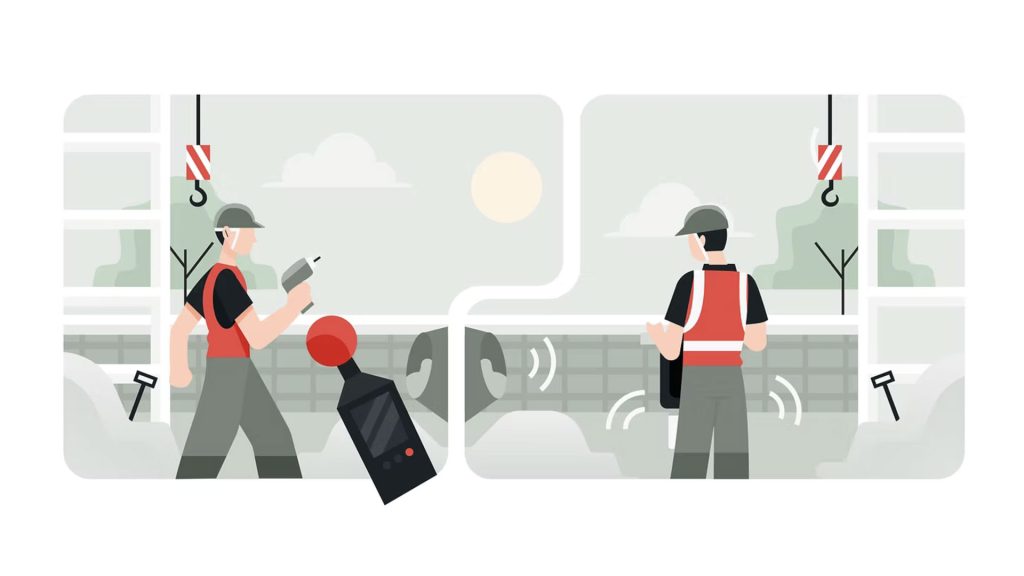
When it comes to improving your approach to anything workplace-related, it’s best to start with a few simple questions: What are you already doing? What impact are your current processes or systems having, at present? What goals are you looking to achieve, moving forward? By investigating your current methods and ways of working, you’ll gain a better understanding of exactly what areas you can improve and refine as you look to the future.
Improving your approach to monitoring and managing occupational noise is no exception. After all, deciding on a risk management plan that balances the health and safety of workers with your organisation’s operational objectives can be a challenge. And that’s exactly why we’ve put together this article: To help teams take stock of their current approach to occupational noise monitoring at work, and understand what specific benefits they can expect when they adopt a more modern solution.
First, we’ll offer you a series of questions that can help you identify areas for improvement and opportunities for insight. Next, we’ll provide you with useful information that can help you elevate your approach to occupational noise monitoring, with confidence.
First, we’ll offer you a series of questions that can help you identify areas for improvement and opportunities for insight
Understanding your current approach to occupational noise monitoring:
- What are you currently doing to monitor exposure to occupational noise? Are you using any technology to monitor workers’ actual exposure to noise? What PPE are workers required to use, and how is that enforced?
- Are you able to monitor exposure to occupational noise on an individual, worker-by-worker basis? Noise levels can vary dramatically between tasks and areas – how does your current approach account for these differences?
- Are you able to monitor individual workers’ exposure to occupational noise over time? Hearing loss is cumulative, meaning it occurs over time: Does your current approach allow you to understand your workers’ exposure to noise over the course of entire shift, days, weeks, or longer?
- Does your current approach allow you to collect data about your workers’ exposure to occupational noise? Data-driven decision-making has become the hallmark of successful, competitive organisations: Does your current approach offer you insights and intelligence that you can use to implement or improve your controls and ways of working?
- If you’ve historically relied upon professional risk assessments of your noise environment, how do you utilise the information provided by the risk assessment? Who has access to this information? What meaningful steps can team members take in response to the information contained in the assessment? How is that knowledge gained from that assessment shared with the team members?
- Does your current working environment reflect the same or substantially similar conditions to when your last risk assessment was carried out? Risk assessments provide teams with a snapshot of their noise environment – in dynamic workplaces, conditions change fast and often – does your risk assessment adequately reflect your actual working environment? What would happen if conditions changed quickly? How long would it take you to get reliable information about your workers’ exposure to noise
- Do you use technology to monitor your workers’ exposure to other potentially dangerous sources of workplace risk? Are you using wearable devices to monitor workers’ exposure to HAV or dust? Do you use beacons or tags to set up exclusion zones? If so, how have these systems helped your teams to stay safer, or improved operations?
By answering the above questions and discussing them with your team, you’ll gain a deeper understanding about the current state of your approach to noise monitoring. You’ll likely determine where there’s room for improvement, but you may also discover areas where you’ve already taken meaningful steps forward. Ultimately, it’s important to regularly check-in with your processes, systems, and approaches to see what’s working well for your teams and your business and identify where you could be getting more from your health and safety efforts.
Key Considerations for a Human-Centred Approach to Occupational Noise Monitoring
Improving your approach to noise monitoring isn’t just about data, it’s about people. At Noise Smart, we believe that the most effective safety strategies are built around the way humans actually work: dynamically, imperfectly, and often unconsciously. Real-world safety risks aren’t static, and neither are the decisions workers make throughout a shift.
That’s why a modern approach to occupational noise monitoring should reflect the complexity of human behaviour – accounting for the fallibility, unpredictability, and adaptability of people in real environments. Rather than relying solely on periodic assessments or outdated compliance models, a more human-centred solution offers real-time insights that empower better decisions in the moment.
- See clearly – Gain visibility into real-world exposure as it happens, not just in hindsight.
- Act confidently – Make informed decisions that improve both compliance and care.
- Support behaviour change – Encourage safer habits by making risk tangible and immediate.
- Measure what matters – Go beyond proving that nothing went wrong, and start demonstrating the presence of proactive safety.
By designing with humans in mind, by acknowledging unconscious habits, variable compliance, and the realities of busy workplaces, you can shift from reactive box-ticking to a proactive culture of care. Noise Smart helps teams not only meet their obligations but go further: building healthier environments, reinforcing accountability, and protecting long-term hearing health.
Smart Alert offers teams the opportunity to get all of these benefits, and more, from their approach to noise monitoring. A purpose-built, lightweight solution, Smart Alert is the next step for teams who want to elevate their approach to risk management in this area.
To learn more about what sets Smart Alert apart and to better understand how it can redefine the way you approach noise monitoring at work, we suggest you check out this eguide.
And when you’re ready to explore Smart Alert in more detail, just book a free product demo with a member of our team.




